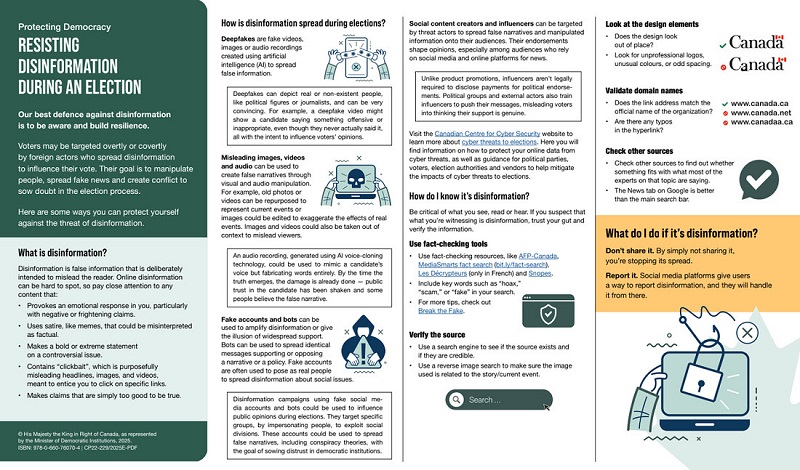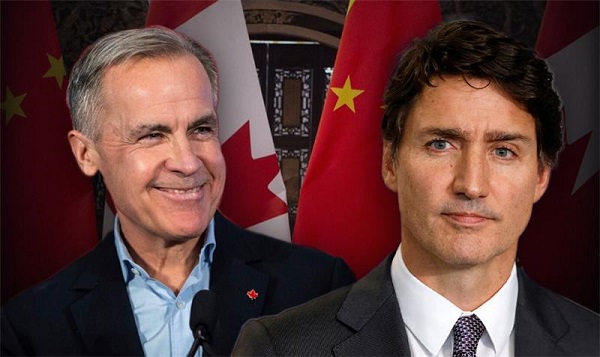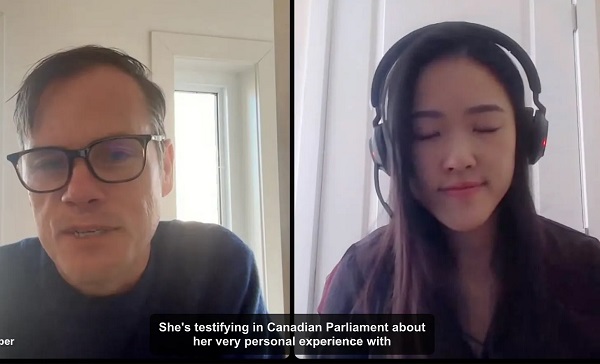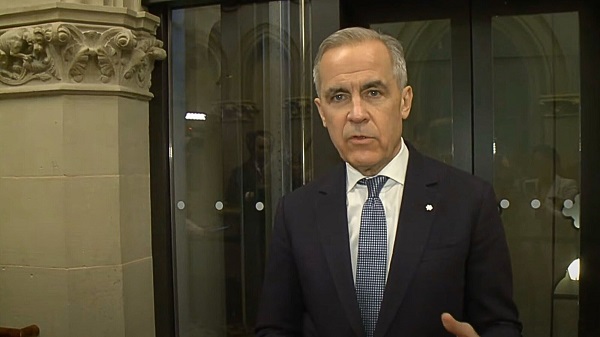Health
How gender activists stole the media, distorted medicine, and hurt Canadian kids:

 By Mia Hughes for Inside Policy
By Mia Hughes for Inside Policy
News outlets abandoned balanced reporting on medical transitions for minors long ago
There is a major medical scandal unfolding in Canada, and our media is fueling it. In gender clinics across the country, doctors put healthy adolescents on invasive medical procedures that can impair fertility, sexual function, and bone density, damage bodily systems, and result in the removal of healthy organs. Teenage girls are being put into menopause, and young men are being chemically and surgically castrated. This is all done without a clear diagnosis or solid scientific evidence that these treatments are safe or beneficial.
Yet Canada’s mainstream media portrays these interventions, euphemistically called “gender-affirming care,” as evidence-based, medically necessary, and lifesaving. Top outlets such as CBC, CTV, and Global present paediatric gender medicine as uncontroversial.
Flawed Coverage Putting Canada’s Youth at Risk
The scandal of paediatric gender medicine contains all the elements of a sensational news story – conspiracy, intrigue, deception, and blackmail. It involves powerful institutions suppressing dissent, whistleblowers risking their careers to speak out, and innocent young people being harmed in the crossfire. There are medical professionals ignoring basic ethical principles, activists influencing policy under the guise of science, and victims being vilified and silenced. All this should prove irresistible to the inquisitive journalistic mind.
Which makes it all the more puzzling that, aside from the National Post, Canada’s mainstream media has opted to ignore the story and instead act as a mouthpiece for extremist trans activists, uncritically echoing their talking points. To understand how harmful and inaccurate the mainstream coverage of this issue is, it is essential to debunk the key claims of the trans activist lobby.
Let’s start with puberty blockers as a fully reversible pause. CBC first reported this claim in 2012, when the puberty suppression experiment was still in its infancy, then it pops up consistently throughout the intervening years, all the way up to the present day and the network’s dismal coverage of England’s Cass Report in 2024. CBC also feeds this misinformation directly to children in a CBC Kids article from 2023.
CTV, Global, the Globe and Mail, and others are equally guilty of spreading this inaccuracy to the public. It is understandable that many Canadians believe puberty blockers are a fully reversible pause and that therefore restricting access to these drugs is unnecessary government overreach. The trouble is the claim is false.
In truth, before Dutch researchers introduced puberty suppression for trans-identified adolescents, studies showed that 63 per cent to 98 per cent of youth eventually outgrew their gender distress. However, once puberty blockers were implemented, nearly all adolescents progressed to irreversible cross-sex hormones, with persistence rates of 98 per cent to 100 per cent. The explanation for this striking reversal of persistence rates is that the cognitive and sexual development that occurs during puberty naturally resolves gender dysphoria in most cases. Blocking puberty, therefore, means blocking the natural cure for gender-related distress.
Yet our mainstream media continues to call puberty blockers reversible because Canada’s “experts” in “gender-affirming care” continue to cling to this belief, despite the mounds of scientific evidence to the contrary. It is the same for the claim that affirming a young person’s transgender identity and providing access to puberty blockers, cross-sex hormones, and surgeries amounts to “life-saving care.” The most pernicious of all trans activist misinformation, the transition-or-suicide narrative is ubiquitous in Canada’s mainstream coverage of this controversial medical treatment.
There are many examples. The most reprehensible is in the CBC Kids piece, in which a young trans-identified person is quoted as saying, “If I wasn’t able to start this therapy, honestly, I probably wouldn’t be here anymore.” This content directly contradicts suicide prevention guidelines, which emphasize that the media must never oversimplify or attribute suicide to a single cause because suicide is known to be socially contagious.
The truth is the transition-or-suicide claim rests on exceptionally flimsy scientific evidence. Surveys of trans-identified youth do show increased risk of suicidal thoughts and suicide attempts, but completed suicide in this population is rare. The elevated risk is likely due to co-existing mental health issues that are extremely common in youth who identify as transgender. All systematic reviews to date have found no good quality evidence to support the transition-or-suicide narrative, and the Cass Report and a recent robust study out of Finland reached the same conclusion.
The final most common falsehood repeated by our top news outlets is that very few people regret undergoing these hormonal and surgical procedures. This appears regularly in articles on the subject. Once again, this falsehood appears in the same CBC Kids article, in which children are told that regret is experienced by only “around one per cent of all patients who received gender-affirming surgery, according to a review of 27 studies.” (Of note, the review cited by CBC is among the most poorly conducted study in a field already known for exceptionally low standards, leading one exasperated critic of the paper to ask, “where exactly is the line between incompetence and fraud?”)
These falsehoods remain ever-present in Canada’s reporting on paediatric gender medicine because our journalists have misplaced trust in medical associations, most notably the World Professional Association for Transgender Health (WPATH). WPATH, an activist group masquerading as a medical association, has been thoroughly discredited in recent years, but these revelations have failed to penetrate the Canadian media landscape.
Even more remarkably, it is not only the media who were duped by WPATH. Almost every major medical association in North America, including the Canadian Paediatric Society, follows the lead of this fraudulent activist group that sets standards of care based on flimsy science, buries evidence that does not align with its political goals, and believes “eunuch” is a valid gender identity even children can possess.
The WPATH Files, released in March 2024, revealed professionals within WPATH, including a prominent Canadian endocrinologist, are aware that children and adolescents are not capable of understanding the lifelong implications of puberty suppression, that there is significant regret among this cohort, and that gender-affirming clinicians are conducting an unregulated experiment on people who identify as transgender.
How Activists Shaped the Narrative
In October 2011, CBC’s The Passionate Eye aired a documentary titled Transgender Kids. The four children featured in the film were some of the earliest participants in the puberty suppression experiment and the filmmakers compassionately tackled some tough questions, such as how young is too young? And how should parents respond to their child’s desire for these extreme medical interventions?
This was the first time CBC had reported on “transgender children,” a brand-new type of human being only made possible by the puberty suppression experiment. What happened next very likely shaped the way the institution handled the issue going forward.
On January 27, 2012, Egale, which describes itself as a “2SLGBTQI+” charity, published an open letter accusing the CBC of “violence” towards “transgender children” due to repeated instances of misgendering in the documentary. According to Egale, “this significantly increases the likelihood that the viewing public will incorrectly view these children as victims of ‘gender confusion’ and their parents as horribly misguided.” The group demanded a public apology from CBC and recommended that the public broadcaster use the GLAAD media style guide going forward when reporting on trans issues.
Egale’s public response sent a clear warning to Canadian media: questioning whether children and adolescents could truly be transgender or make such life-altering decisions would not be tolerated. As a result, from the outset, activists tied the experiment to change the sex of children to a human rights cause, dictated the tone of media coverage, and effectively forbade genuine journalistic scrutiny of these invasive medical procedures.
The highly publicized suicide of trans-identified teen Leelah Alcorn in 2014 injected the “transition-or-suicide” myth into the Canadian mainstream narrative. Trans activists seized on Alcorn’s suicide note as supposed proof that affirmation and medical interventions saved lives, and from that moment on, our news outlets led parents to believe that questioning their child’s sudden transgender identity or desire for irreversible hormones and surgeries could have fatal consequences.
Having learned its lesson five years previously, in 2017, CBC pulled a second documentary called Transgender Kids: Who Knows Best before it aired after “over a dozen” complaints from Canadian trans activists. The activists claimed the documentary was “harmful, would “disseminate inaccurate information about trans youth and gender dysphoria,” and would “feed transphobia.”
In reality, the documentary was fair and measured. It contained all the standard trans activist talking points but also presented the opposing perspective. It featured Dr. Kenneth Zucker, who highlighted the historically high desistance rates before the introduction of puberty blockers and pointed out that many children experiencing gender distress would likely grow up to be gay.
This is what journalism is meant to do: present the full picture. But in a media landscape dominated by trans activists, news outlets abandoned balanced reporting.
A Lesson from the Past
In May 1941, the Saturday Evening Post published an article with the headline “Turning the Mind Inside Out.” In it, Waldemar Kaempffert, an editor of the New York Times, described a miraculous new brain surgery called a lobotomy that cut “worries, persecution complexes, suicidal intentions, obsessions, indecisiveness and nervous tensions” out of the mind. Kaempffert compared the procedure that involved blindly swinging knives inside a patient’s brain to the delicate work of a watchmaker.
Kaempffert’s article was just one of many glowing media endorsements of what would become one of medicine’s greatest atrocities. With each published piece, word spread, offering desperate families a false sense of hope. Encouraged by the promise of a “cure,” relatives sought lobotomies for their loved ones – including, most famously, the Kennedys, who, in the same year as Kaempffert’s article, subjected their daughter Rosemary to the procedure, with devastating consequences.
The misleading coverage of “gender-affirming care” has a similarly dangerous impact. First, each article reinforces the pseudoscientific notion that some children are transgender, embedding this idea into public consciousness and fueling the social contagion of adolescents adopting trans identities. Then, with every article that exaggerates the benefits of hormones and surgeries and downplays the harms, young people come to believe that this medical treatment is the solution to their pain. However, minors do not sign consent forms. That is the responsibility of parents.
Therefore, consider the real-world consequences of the falsehoods our journalists are propagating. Parents who rely on mainstream media may make disastrous decisions for their child based on ideologically driven narratives.
Glimmers of Courage
Amidst a sea of misinformation, there has been the occasional glimmer of courage. In 2021, CTV’s W5 produced a balanced segment showcasing the voices of detransitioners and asking whether there was adequate safeguarding in youth gender medicine.
In February 2024, Radio-Canada’s Enquête team produced a stunning piece of investigative journalism in which an actress posing as a trans-identified 14-year-old obtained a prescription for testosterone after just a nine-minute appointment at a private gender clinic in Quebec. In response, local trans activists smashed the windows of the Radio-Canada headquarters in Montreal. Then in April 2024, the Globe and Mail published a balanced and thoroughly researched opinion piece calling for a review of Canada’s approach to treating this vulnerable cohort.
CBC’s The National tackled the issue twice, approximately one year apart, and the second showed some measure of improvement in willingness to grapple with the complexity of the issue. However, this is nowhere near enough. These brief glimmers of hope are still drowned out in a sea of activist propaganda.
A Call to Action
One of the greatest challenges in exposing the scandal of paediatric gender medicine is that the truth is so shocking it defies belief. To the average person, it seems impossible that an entire medical field could be hijacked by an unscientific and irrational ideology – that endocrinologists could be chemically castrating healthy adolescents without solid scientific justification, that surgeons could be removing the healthy breasts of teenage girls without any proof of benefit, and that the World Professional Association for Transgender Health could have fraudulently duped the entire medical world into endorsing a reckless, ideology-driven experiment with no scientific underpinning. It sounds like a wild conspiracy theory. Yet every word is true.
Which means now more than ever, journalists must do their job – question, investigate, and expose the corruption of gender medicine. Skeptics need a platform, victims must be heard, and the harms must be scrutinized. Now is the time to plainly state that there is no evidence that “gender-affirming care” is lifesaving, puberty blockers are neither evidence-based nor reversible, and detransition rates are clearly rising. For over a decade, Canadian media have trusted activist-clinicians and the discredited WPATH while ignoring or vilifying those fighting to protect young people. This must end – immediately.
Mia Hughes specializes in pediatric gender medicine, psychiatric epidemics, social contagion and the intersection of trans rights and women’s rights. She is the author of “The WPATH Files” and a senior fellow at the Macdonald-Laurier Institute.
2025 Federal Election
MEI-Ipsos poll: 56 per cent of Canadians support increasing access to non-governmental healthcare providers

-
Most believe private providers can deliver services faster than government-run hospitals
-
77 per cent of Canadians say their provincial healthcare system is too bureaucratic
Canadians are increasingly in favour of breaking the government monopoly over health care by opening the door to independent providers and cross-border treatments, an MEI-Ipsos poll has revealed.
“Canadians from coast to coast are signalling they want to see more involvement from independent health providers in our health system,” explains Emmanuelle B. Faubert, economist at the MEI. “They understand that universal access doesn’t mean government-run, and that consistent failures to deliver timely care in government hospitals are a feature of the current system.”
Support for independent health care is on the rise, with 56 per cent of respondents in favour of allowing patients to access services provided by independent health entrepreneurs. Only 25 per cent oppose this.
In Quebec, support is especially strong, with 68 per cent endorsing this change.
Favourable views of accessing care through a mixed system are widespread, with three quarters of respondents stating that private entrepreneurs can deliver healthcare services faster than hospitals managed by the government. This is up four percentage points from last year.
Countries like Sweden and France combine universal coverage with independent providers and deliver faster, more accessible care. When informed about how these health systems run, nearly two in three Canadians favour adopting such models.
The poll also finds that 73 per cent of Canadians support allowing patients to receive treatment abroad with provincial coverage, which could help reduce long wait times at home.
Common in the European Union, this “cross-border directive” enabled 450,000 patients to access elective surgeries in 2022, with costs reimbursed as if they had been treated in their home country.
There’s a growing consensus that provincial healthcare systems are overly bureaucratic, with the strongest agreement in Alberta, B.C., and Quebec. The proportion of Canadians holding this view has risen by 16 percentage points since 2020.
Nor do Canadians see more spending as being a solution: over half say the current pace of healthcare spending in their province is unsustainable.
“Governments shouldn’t keep doubling down on what isn’t working. Instead, they should look at what works abroad,” says Ms. Faubert. “Canadians have made it clear they want to shift gears; now it’s up to policymakers to show they’re listening.”
A sample of 1,164 Canadians aged 18 and older was polled between March 24th and March 28th, 2025. The margin of error is ±3.3 percentage points, 19 times out of 20.
The results of the MEI-Ipsos poll are available here.
* * *
The MEI is an independent public policy think tank with offices in Montreal, Ottawa, and Calgary. Through its publications, media appearances, and advisory services to policymakers, the MEI stimulates public policy debate and reforms based on sound economics and entrepreneurship.
Health
Trump admin directs NIH to study ‘regret and detransition’ after chemical, surgical gender transitioning

From LifeSiteNews
Ample evidence has surfaced in recent years to warrant the White House’s investigation
The Trump administration has made a break with the long-standing government policy of near 100% affirmation of the transgender industry’s efforts and has directed the National Institutes of Health (NIH) to study the negative impacts on mental and physical health of so-called “gender transitioning” on adults and children.
The Department of Health and Human Services (HHS), which oversees NIH, “has been directed to fund research on a few specific areas” regarding “chemical and surgical mutilation” of children and adults,” according to multiple reports.
In particular, the Trump administration wants to investigate “regret and detransition following social transition as well as chemical and surgical mutilation of children and adults” and “outcomes from children who have undergone social transition and/or chemical and surgical mutilation.”
The new directives to the biomedical agency were reportedly included in an email to several NIH directors from then-Acting NIH Director Matthew Memoli shortly after Trump took office.
“This is very important to the President and the Secretary (of HHS, Robert F. Kennedy Jr.),” Memoli wrote.
Unhappy about the Trump administration’s move to uncover the hidden, shadowy side of the burgeoning transgender industry, pro-transgender activists working within the medical research community were quick to criticize the move.
The term “chemical or surgical mutilation” was “deeply offensive,” said Harry Barbee, assistant professor at the Johns Hopkins Bloomberg School of Public Health.
“This terminology has no place in serious scientific or public health discourse,” Barbee complained. “The language has been historically used to stigmatize trans people. Even the phrase(s) ‘regret’ and ‘detransition’ can be weaponized.”
“What they’re looking for is a political answer not a scientific one,” Adrian Shanker, who served as deputy assistant secretary for health policy at HHS under President Biden, told NPR. “That should be an alarm for everyone who cares about the scientific integrity of the National Institutes of Health.”
While those who derive a living focusing on developing and expanding the transgender industry resent the implication that there might be a dark side to their efforts, more than ample evidence has surfaced in recent years to warrant the White House’s investigation on behalf of vulnerable Americans, especially children, who have shown to be highly susceptible to what has been called the “transgender contagion.”
Many oft-ignored detransitioners attest to the physical and mental harm of reinforcing gender confusion as well as to the bias and negligence of the medical establishment on the subject, many of whom take an activist approach to their profession and begin cases with a predetermined conclusion in favor of “transitioning.”
A study published earlier this year in the Oxford Journal of Sexual Medicine found that undergoing sex-change surgery, far from reducing depression rates among the gender dysphoric, substantially increased rates not only of depression but of anxiety, suicidal ideation, and substance use disorders.
This study, along with scores of others conducted in recent years, explodes the media-enforced narrative that so-called “gender affirming” medical treatments are necessary for the happiness and well-being of the gender-confused.
Short video displays deep regret after sex-change treatments and surgery
A short video – just 34 seconds long – displays the extreme distress and anxiety of those who resorted to surgery and hormone treatments to “transition” earlier in their lives, only to experience deep regret later on.
The video presents a cautionary tale, dispelling the myth that parents need to allow their children to transition in order to be happy.
“Society is marketing a horrifically harmful, fashionable new trend to children that brings about a life of depression, confusion, drug use and STD’s,” the caption reads. “Please inform yourselves and help your children.”
Former transgender: ‘Regret’ and ‘detransitioning’ are the new trans frontier
Walt Heyer, a former “transgender woman” who for many years has maintained a global outreach to those who experience sex change regret, has been sounding the alarm about the one-size-fits-all approach of the trans medical industry for years.
“The science of surgical interventions is not yet settled regarding the long-term consequences of transgender therapy,” Heyer noted during a 2017 Symposium at the University of Hong Kong. “As of today, we don’t have any objective, conclusive research.”
“I feel ‘regret’ and ‘detransitioning’ will become the next transgender frontier,” Heyer said. “So be prepared.”
“There is an ever-increasing number of former transgenders, like myself, who are now requesting gender reversals,” he said.
“As a former female transgender, I can see the exploding social trend that has developed into a significant transgender contagion —now even an epidemic— that has captivated young children as well as young adults who have come to believe they’re the opposite sex on just the weight of social media and feelings … in some cases taking drastic measures to change their bodies,” Heyer said.
“More and more, I get reports from families telling me that their teen children suddenly came out as a transgender without any prior history of discomfort with their biological sex,” said Heyer, describing what has come to be called “rapid onset gender dysphoria.”
“Current psychotherapeutic practice involves the immediate affirmation of the young person’s self-diagnosis,” he lamented.
Heyer explained that many surgically transformed men and women suffer from a complex number of sexual, emotional, psychiatric and psychological comorbid disorders such as autogynephilia, dissociative disorders like schizophrenia, body dysmorphic disorder, and a host of other undiagnosed disorders that were not resolved by the recommended therapy of changing genders.
Heyer spoke from his own experience as he explained that if such disorders were considered and treated adequately, sexual transitioning would probably be greatly reduced. The role of these “comorbid” conditions tends to surface later as trans individuals begin to question their decision to transition to the opposite sex.
“We find this out from the ‘regretters,’” Heyer said. “We don’t find it out early on. We find it out afterward when they’re seeking help … and we find out that these comorbid disorders existed early on.”
A significant body of evidence now shows that “affirming” gender confusion carries serious harms, especially when done with impressionable children who lack the mental development, emotional maturity, and life experience to consider the long-term ramifications of the decisions being pushed on them or full knowledge about the long-term effects of life-altering, physically transformative, and often irreversible surgical and chemical procedures.
Studies find that more than 80 percent of children suffering gender dysphoria outgrow it on their own by late adolescence, and that “transition” procedures fail to resolve gender-confused individuals’ heightened tendency to engage in self-harm and suicide – and even exacerbate it, including by reinforcing their confusion and neglecting the actual root causes of their mental strife.
-

 Alberta2 days ago
Alberta2 days agoMade in Alberta! Province makes it easier to support local products with Buy Local program
-

 2025 Federal Election24 hours ago
2025 Federal Election24 hours agoEuthanasia is out of control in Canada, but nobody is talking about it on the campaign trail
-

 2025 Federal Election11 hours ago
2025 Federal Election11 hours agoMEI-Ipsos poll: 56 per cent of Canadians support increasing access to non-governmental healthcare providers
-

 2025 Federal Election19 hours ago
2025 Federal Election19 hours agoAI-Driven Election Interference from China, Russia, and Iran Expected, Canadian Security Officials Warn
-

 2025 Federal Election2 days ago
2025 Federal Election2 days agoCSIS Warned Beijing Would Brand Conservatives as Trumpian. Now Carney’s Campaign Is Doing It.
-

 2025 Federal Election2 days ago
2025 Federal Election2 days agoInside Buttongate: How the Liberal Swamp Tried to Smear the Conservative Movement — and Got Exposed
-

 illegal immigration1 day ago
illegal immigration1 day agoDespite court rulings, the Trump Administration shows no interest in helping Abrego Garcia return to the U.S.
-

 Bjorn Lomborg24 hours ago
Bjorn Lomborg24 hours agoGlobal Warming Policies Hurt the Poor







